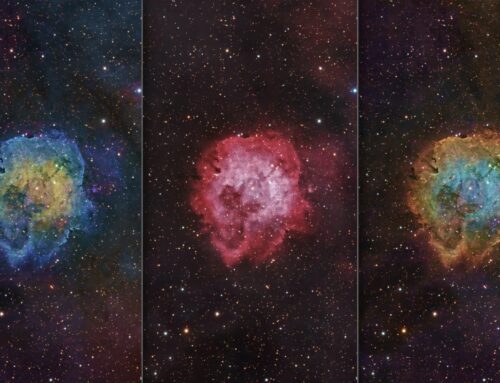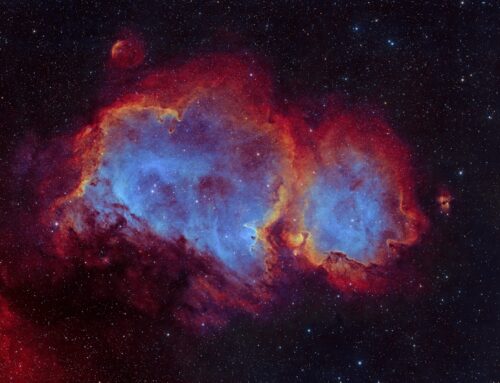Heart and Soul Nebulae, Wide Field
 Click image for full size version
Click image for full size version
November 27, 2019
The Heart Nebula (upper right; IC 1805, Sh2-190), and Soul Nebula (lower left; IC 1848, Westerhout 5, LBN 667, Sh2-199) are large clouds of glowing gas. Both are in Cassiopeia and about 7,500 light years away in the Perseus arm of the Milky Way galaxy. The Heart Nebula is about 165 light years in diameter, with the Soul being a little smaller. To the upper right of the image is the Fishhead Nebula (IC 1795, NGC 896), while the open cluster Melotte 15 lies at the centre of the Heart nebula. That cluster is responsible for causing the hydrogen in this region to glow.
In addition to the main subjects of the image, there are numerous other catalogued objects in this shot that are interesting in their own right. I prepared an annotated image to help you navigate this busy field. IC 1871 is the little patch of detached nebuolosity just left of IC 1848, and it shows some structure on close inspection. Sh2-198 appears below the Soul nebula, with tiny Sh2-191 near the bottom of the image, below the Heart nebula. Sharpless 195 and 197 are hard to see, but present, in the bottom centre of this image. Sharpless 192, 193, 194 and 196 all lie to the left of the Heart nebula, just left of top centre of this image.
Tekkies:
Takahashi FSQ-106 ED IV @ f/3.6, QHY367C one-shot colour camera, and Optolong L-eNhance narrowband filter, Paramount MX, unguided. Acquisition, and focusing with TheSkyX. Focus with Optec DirectSync focus motor and controller. Automation with CCDCommander. Equipment control with PrimaLuce Labs Eagle 3 Pro computer. All pre-processing and processing in PixInsight. Acquired from my SkyShed in Guelph. No moon, average to above average transparency and fair to average seeing. Data acquired August 28 – October 11, 2019.
122x10m with Optolong L-eNhance filter (Total = 20hr20m)
Image scale 2.6 arcsec per pixel
Data Reduction and Cleanup
Preprocessing: The WeightedBatchPreProcessing script was used to perform calibration, debayering, and registration of all frames. ImageIntegration followed by DrizzleIntegration with the CFA Drizzle option was used to make the master, which was then cropped.
Gradient Removal: DBE was applied using Subtraction to remove the minimal gradient that remained after integration.
Channel Registration: To improve channel registration, the RGB colour channels were extracted and aligned with StarAlignment, using Thin Plate Splines with Distortion Correction and the green channel as the reference frame. The registered colour channels were recombined with ChannelCombination.
Lightness Extraction: RGBWorkingSpace was applied to normalize the channels, and the Lightness was extracted for separate processing as described below.
Colour
Colour Balancing: The colour image was colour balanced with ColorCalibration.
Linear Noise Reduction: MultiscaleLinearTransform was used to reduce noise in the background areas, using an internal mask to protect bright structures. Layer settings for threshold and strength: Layer 1: 5.0 0.85 Layer 2: 4.0, 0.75 Layer 3: 3.0, 0.5 Layer 4: 1.0, 0.25.
Stretching: HistogramTransformation was applied to make a pleasing, bright image, with background set to an intensity of approximately 0.10.
Lightness
Deconvolution: StarMask was applied with default settings to produce a Local Deringing Support Image. A clone of the image was stretched to use as a deconvolution mask. Deconvolution was applied (80 iterations, regularized Richardson-Lucy, external PSF made using PSFImage script with about 30 stars).
Linear Noise Reduction: MultiscaleLinearTransform was used to reduce noise in the background areas, using an internal mask to protect bright structures. Layer settings for threshold and strength: Layer 1: 3.0, 0.9 Layer 2: 2.0, 0.75 Layer 3: 1.0, 0.6 Layer 4: 0.5, 0.2.
Stretching: HistogramTransformation was applied to make a pleasing, bright image, with background set to an intensity of approximately 0.10.
Recombining Lightness and Colour Images
LRGB Combination: The lightness image was applied to the RGB image using LRGBCombination with default settings.
Additional Processing
Nonlinear Noise Reduction: TGVDenoise was used in L*a*b* mode to reduce noise with a mask used to target the background areas and protect the stars (max. 1000 iterations and convergence selected for both lightness and chrominance).
Contrast Enhancement: LocalHistogramEqualization was applied twice (scale of 54 with strength 1.0; then scale of 150 with strength 0.5) using a mask to protect stars and low-signal regions of the image. The mask was a stretched version of the Lightness image with stars removed using Starnet++.
Final Steps: Background, nebula and star brightness, contrast, colour saturation were adjusted in several iterations using CurvesTransformation with masks as required. Hue was adjusted using the following expression in PixelMath without rescaling, with a star mask used to protect the stars:
R: $T[0]
G: iif([$T[0]>0.2, 0.94*$T[1], $T[1])
B: iif([$T[0]>0.2, 1.10*$T[2], $T[2])
The DarkStructureEnhance script was applied with a strength of 0.20. The image was rescaled to its original scale of 2.6″/pixel. ICCProfileTransformation (sRGB IEC61966-2.1; Relative Colorimetric with black point compensation) was applied prior to saving as a jpg. And if you read all the way to here, congratulations. You can see the full resolution Drizzled version (1.3″ per pixel), by sending me a comment asking for it!






Hi Ron, I’ll take that offer!!
Many thanks for that and as always, for your detailed explanations!
Lovely wide field, excellent image!!
Thank you sir’, Ron
Not like using the polaroid instamatic , so much work then freely shared with an exclamation. If all science follows your lead we should reach a singularity of sorts in our grand childrens lifetime